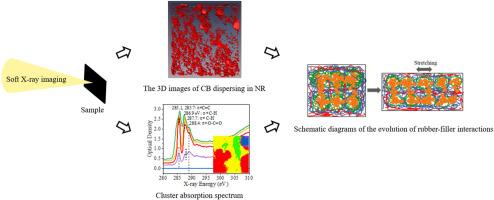Elucidating the roles of carbon black in filler- and rubber-filler interactions using synchrotron Nano-CT and STXM
IF 11.6
2区 材料科学
Q1 CHEMISTRY, PHYSICAL
引用次数: 0
Abstract
To investigate the correlation of carbon black (CB) surface activity to filler-filler and rubber-filler interactions, the CB underwent heat treatment with high-temperature and oxidation with concentrated nitric acid. With synchrotron radiation-based X-ray Nano-CT and scanning transmission X-ray microscopy (STXM), the dispersing structures and rubber-filler interactions of CB with different surface activities in natural rubber (NR) were studied. The results showed that the heated CB with inactive surface tended to gather together in small sizes and dispersed homogeneously in NR, while the oxidized CB aggregated in big sizes and dispersed inhomogeneously in non-polar NR. Meanwhile, oxygen-containing functional groups (C–O, C![]() O) on CB surface were strongly conjugated with C–H groups from NR and induced C–H group orientations, and the more activities on the CB surface, the stronger rubber-filler interactions. With the measured stress-strain curves and the stress-bearing and strain-bearing double network models, the moduli of the CB fillers in NR were calculated. A nonlinear increase of the CB filler moduli was observed as compared to the CB content in NR. Specifically, with the CB content increasing 5 times, the CB filler moduli increased about 10 times or more. This suggest that the CB filler-filler interactions (filler network structures) are more effective in NR reinforcement than rubber-filler interactions. Thus, the modulus of the heated CB with weak rubber-filler interactions was larger than that of the oxidized CB with strong rubber-filler interactions. The insightful information provides a valuable perspective on the CB reinforcement mechanisms and the design of new rubber composites with specific properties.
O) on CB surface were strongly conjugated with C–H groups from NR and induced C–H group orientations, and the more activities on the CB surface, the stronger rubber-filler interactions. With the measured stress-strain curves and the stress-bearing and strain-bearing double network models, the moduli of the CB fillers in NR were calculated. A nonlinear increase of the CB filler moduli was observed as compared to the CB content in NR. Specifically, with the CB content increasing 5 times, the CB filler moduli increased about 10 times or more. This suggest that the CB filler-filler interactions (filler network structures) are more effective in NR reinforcement than rubber-filler interactions. Thus, the modulus of the heated CB with weak rubber-filler interactions was larger than that of the oxidized CB with strong rubber-filler interactions. The insightful information provides a valuable perspective on the CB reinforcement mechanisms and the design of new rubber composites with specific properties.

利用同步加速器纳米ct和STXM研究炭黑在填料和橡胶填料相互作用中的作用
为了研究炭黑(CB)表面活性与填料-填料和橡胶-填料相互作用的关系,对CB进行了高温热处理和浓硝酸氧化。利用同步辐射x射线纳米ct和扫描透射x射线显微镜(STXM)研究了不同表面活性的丁二烯在天然橡胶(NR)中的分散结构及其与橡胶填料的相互作用。结果表明:表面无活性的炭黑加热后在NR中呈小尺寸聚集均匀分布,而氧化后的炭黑在非极性NR中呈大尺寸聚集不均匀分布,炭黑表面的含氧官能团(C-O、CO)与NR中的C-H基团发生强共轭并诱导C-H基团取向,炭黑表面活性越强,与橡胶填料的相互作用越强。利用实测的应力-应变曲线和应力-应变双网络模型,计算了CB填料在NR中的模量。与NR中炭黑含量相比,炭黑填料模量呈非线性增长,炭黑含量增加5倍,炭黑填料模量增加约10倍以上。这表明,与橡胶-填料相互作用相比,炭黑填料-填料相互作用(填料网络结构)在NR增强中更有效。因此,加热后橡胶与填料之间弱相互作用的炭黑的模量比氧化后橡胶与填料之间强相互作用的炭黑的模量大。这些深刻的信息为CB增强机制和具有特定性能的新型橡胶复合材料的设计提供了有价值的视角。
本文章由计算机程序翻译,如有差异,请以英文原文为准。
求助全文
约1分钟内获得全文
求助全文
来源期刊

Carbon
工程技术-材料科学:综合
CiteScore
20.80
自引率
7.30%
发文量
0
审稿时长
23 days
期刊介绍:
The journal Carbon is an international multidisciplinary forum for communicating scientific advances in the field of carbon materials. It reports new findings related to the formation, structure, properties, behaviors, and technological applications of carbons. Carbons are a broad class of ordered or disordered solid phases composed primarily of elemental carbon, including but not limited to carbon black, carbon fibers and filaments, carbon nanotubes, diamond and diamond-like carbon, fullerenes, glassy carbon, graphite, graphene, graphene-oxide, porous carbons, pyrolytic carbon, and other sp2 and non-sp2 hybridized carbon systems. Carbon is the companion title to the open access journal Carbon Trends. Relevant application areas for carbon materials include biology and medicine, catalysis, electronic, optoelectronic, spintronic, high-frequency, and photonic devices, energy storage and conversion systems, environmental applications and water treatment, smart materials and systems, and structural and thermal applications.
 求助内容:
求助内容: 应助结果提醒方式:
应助结果提醒方式:


